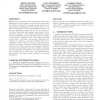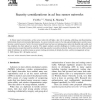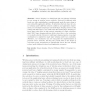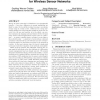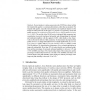567 search results - page 59 / 114 » Centrality-based routing for Wireless Sensor Networks |
109
click to vote
WSNA
2003
ACM
15 years 5 months ago
2003
ACM
Efficiently self organizing a network hierarchy with specific assignment of roles (or tasks) to sensors based on their physical wireless connectivity and sensing characteristics ...
108
click to vote
ADHOC
2005
14 years 11 months ago
2005
In future smart environments, ad hoc sensor networks will play a key role in sensing, collecting, and disseminating information about environmental phenomena. As sensor networks c...
82
Voted
EWSN
2009
Springer
16 years 13 days ago
2009
Springer
Sensor sleeping is a widely-used and cost-effective technique to save energy in wireless sensor networks. Protocols at different stack levels can, either individually or simultaneo...
107
click to vote
SENSYS
2009
ACM
15 years 6 months ago
2009
ACM
Energy in sensor networks is a distributed, non-transferable resource. Over time, differences in energy availability are likely to arise. Protocols like routing trees may concent...
115
click to vote
EUC
2005
Springer
15 years 5 months ago
2005
Springer
Recent studies in wireless sensor networks (WSN) have observed that the irregular link quality is a common phenomenon, rather than an anomaly. The irregular link quality, especiall...
